When did the “Gentleman’s Magazine” print the Declaration of Independence?
November 14, 2011 by TimHughes · 5 Comments
 Fellow collector Michael Gulvin asks a question which many other collectors may have wondered: “On what day of the month did the Gentleman’s Magazine for August, 1776 become available? We have a time-line for the American newspapers, and we know that the London Chronicle printed the Declaration in its August 17th issue, but do we know the actual date the Gentleman’s Magazine printed the Declaration of Independence for its August issue?”
Fellow collector Michael Gulvin asks a question which many other collectors may have wondered: “On what day of the month did the Gentleman’s Magazine for August, 1776 become available? We have a time-line for the American newspapers, and we know that the London Chronicle printed the Declaration in its August 17th issue, but do we know the actual date the Gentleman’s Magazine printed the Declaration of Independence for its August issue?”
Magazines typically published very late in the month shown on the title/contents page. With the “London Chronicle” publishing the Declaration of Independence in its August 17, 1776 issue, and presuming they had interest in publishing such a significant document as early as possible, it is presumed the Declaration was received in London very close to that date. Their previous issue was dated Aug. 15, so August 15-17 would be the presumed period when the document arrived in London. It is curious to note that the “London Gazette” never printed the Declaration of Independence.
Monthly publications are more difficult to pin down in terms of publication dates, however datelines of news reports found within offer great clues. The Historical Chronicle near the back of the August issue of the “Gentleman’s Magazine” has datelines beginning July 10 and the latest date mentioned is August 31, the very last day of the month. Obviously the magazine could not have printed prior to August 31, so the first day or two of September would be the presumed printing dates.
The same was true with American magazines as I recall the June, 1776 issue of “The Pennsylvania Magazine” had the very significant announcement that Congress had voted to approve the Declaration of Independence, with a dateline of July 2, 1776. Obviously that June issue was printed early the following month.
Colonial newspaper founded by a woman… A rare find…
October 31, 2011 by TimHughes · Leave a Comment
A recent collection which came into our inventory included a rare title which didn’t strike me until I looked more closely.
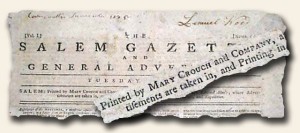 “Salem Gazette” is a somewhat common from the 18th century so I wasn’t surprised to see the title when quickly examining the collection. But then I noticed the date from the Revolutionary War, which I thought odd. Upon investigation I found there were actually four different newspapers titled “Salem Gazette“, one from 1774-1775, one from 1781-85, and one from 1790 thru the 19th century. These latter two are were quite familiar to me, but our issue was yet a fourth title, one which I had never encountered in 35 years, and this one lasted but 36 issues during the year 1781. But of greater significance was that the masthead noted it was published by a woman, Mary Crouch. See the hyperlink for much more on her fascinating life, but suffice it to say she was no stranger to publishing a newspaper as she had much experience in South Carolina.
“Salem Gazette” is a somewhat common from the 18th century so I wasn’t surprised to see the title when quickly examining the collection. But then I noticed the date from the Revolutionary War, which I thought odd. Upon investigation I found there were actually four different newspapers titled “Salem Gazette“, one from 1774-1775, one from 1781-85, and one from 1790 thru the 19th century. These latter two are were quite familiar to me, but our issue was yet a fourth title, one which I had never encountered in 35 years, and this one lasted but 36 issues during the year 1781. But of greater significance was that the masthead noted it was published by a woman, Mary Crouch. See the hyperlink for much more on her fascinating life, but suffice it to say she was no stranger to publishing a newspaper as she had much experience in South Carolina.
The hyperlinked article mentions she took over the publication of her husband’s (Charles) “South Carolina Gazette” after he died in 1772. She then began her own newspaper, the “Charlestown Gazette“, in August of 1778. When the British occupied her town in 1780, being a staunch patriot, she moved north to Salem, Massachusetts, where she began publishing this “Salem Gazette” in 1781. The number we have is dated February 6, 1781 and is issue number 6 of the 36 published (see the hyperlink). Relatively few institutions hold any issues of this title, and only four issues of this date are held by institutions.
There were a number of women who published newspapers in the 18th century & virtually all that I could discover did so by continuing a printing business upon the demise of their respective husbands. One exception was Mary Goddard who published the “Maryland Journal” during her brother’s absence from 1774-1783. But Anne Catherine Green took over her late husband’s “Maryland Gazette” upon his death in 1767; Hannah Watson took over her husband’s (Ebenezer) “Connecticut Courant” upon his death in 1777; Margaret Draper took over the “Massachusetts Gazette” upon the death of her husband Richard in 1774; Clementine Rind took over “The Virginia Gazette” in 1773 when her husband William died; and Ann Franklin published the “Newport Mercury” upon the death of her son James in 1762. I am sure there are others as well.
From what I could determine Mary Crouch may well be the first American woman to create a newspaper, and she did so twice. Her first being the “Charlestown Gazette” and her second the “Salem Gazette“. Any research to the contrary would be gratefully received and shared with our fellow collectors.
Condition and pricing…
October 10, 2011 by TimHughes · 3 Comments
 Many collectors may wonder what the relationship is between the condition of a newspaper and its price. Obviously the condition of a newspaper is subjective, and some problems bother some collectors more than others. But for issues offered through our company here are my thoughts as to how I price our newspapers:
Many collectors may wonder what the relationship is between the condition of a newspaper and its price. Obviously the condition of a newspaper is subjective, and some problems bother some collectors more than others. But for issues offered through our company here are my thoughts as to how I price our newspapers:
* “Natural” faults are less of a problem than human-created. By this I mean problems with foxing (a darkening of portions due to the natural aging of the chemicals in the paper or the environment in which the newspaper was stored), folds, and minor edge tears. Such disfigurements are to be expected with newspapers of a certain age, and if considerable do affect the price but less so than other disfigurements. Even water staining I would consider a natural fault and can be excused as something to be expected and a minor problem if not causing loss of readability.
* Human-created disfigurements would include old tape mends & stains, trimming at the margins such that letters or words are partially shaved (caused when the bindery cuts too close to the text), lengthy tears into text, holes, portions clipped, etc. Such problems are annoying & could have been avoided with better care and I tend to discount the price of a newspaper more liberally than newspapers with natural faults. How much? It depends on the degree of the problem, so subjectivity is very important. If a newspaper has a noteworthy report which is not affected by the damage, it would be discounted less than had the notable report been affected. A small 2 by 1 inch piece clipped from the back leaf would be discounted less than a 2 by 10 inch clipped issue. A disfigurement to an inside page might result in a minimal price adjustment if the issue is offered for the displayability of the front page.
* Irregular margins, caused when a newspaper is improperly removed from a bound volume, will result in lowered values if the irregularity causes loss of type. Most irregular margins involve only the blank spine & the price adjustment would be minimal.
* Some damaged issues are relegated to our damaged pile to be sold in lots of 100 or more at a discounted price. But rare or historic issues are offered individually & priced according to the damage. Many collectors are attracted to damaged, discounted newspapers as they provide an opportunity for rare or historic reports at a much lower cost.
* Particularly bothersome to me are issues which are close-trimmed. Had the worker doing the trimming at the bindery been more carefully such faults could easily be avoided.
* Less bothersome are wear problems with “never bound” newspapers. Such issues are in their natural state as provided to the subscriber or sold on the newsstand, and logically tend to be more worn than issues taken from bound volumes. Such natural wear, when minimal, adds a certain patina to the item and would not detract from its value. For serious collectors, never-bound issues are preferable to issues from bound volume, but tend to be considerably less common.
* Guillotined issues, which are mechanically cut cleanly at the spine to facilitate microfilming, is a minor disfigurement if ample spine margin remains. Depending on the issue we might rejoin the issue at the spine with glue, rejoin using archival tape, or simply keep the issue loose.
* Repairing issues can be controversial. Some believe in repairing tears and others prefer they be left as is. In general I tend to repair rather than not repair. My primary reason is to prevent further tearing which can occur when a leaf is turned, as a tear is a weak spot which often gets worse when handling. We use a very thin strip of archival tape which does not stain and is almost invisible if properly used. When an issue is extensively repaired mention is made in the description. A newspaper’s price may be affected when archivally repaired, depending on the extensiveness of such repairs.
Ideas on how to collect Rare & Early newspapers…
July 30, 2011 by GuyHeilenman · Leave a Comment
 While we at Rare Newspapers’ History’s Newsstand Blog are committed to continually adding material to help support the hobby, every now and then we come across informative material produced by others. Just recently we found a set of videos related to the collectible produced by eHow.com. They may be viewed at:
While we at Rare Newspapers’ History’s Newsstand Blog are committed to continually adding material to help support the hobby, every now and then we come across informative material produced by others. Just recently we found a set of videos related to the collectible produced by eHow.com. They may be viewed at:
http://www.ehow.com/videos-on_5949_collecting-comics-newspapers_-tips-strategies.html
Please enjoy!
America history in British newspapers…
May 23, 2011 by TimHughes · Leave a Comment
 After 35 years in the hobby I can honestly say today as I said then: collecting early newspapers is an inexpensive hobby when compared to other collectibles of like vintage. And the reason is basic economics: supply and demand. Although the collecting fraternity has increased through the years, and the supply of early newspapers has dwindled some, prices still remain a relative bargain for material over 100—and over 200—years old.
After 35 years in the hobby I can honestly say today as I said then: collecting early newspapers is an inexpensive hobby when compared to other collectibles of like vintage. And the reason is basic economics: supply and demand. Although the collecting fraternity has increased through the years, and the supply of early newspapers has dwindled some, prices still remain a relative bargain for material over 100—and over 200—years old.
Exceptions exist. American newspapers of the 18th century are few and far between today. When I began in the hobby in the mid-1970’s, finding the occasional 18th century bound volume of American newspapers was rather common. I even purchased a number of volumes of colonial and Revolutionary War newspapers printed in the colonies. Such purchases are very rare today, and consequently prices for American titles before the1790’s can be exorbitant for many collectors.
Which brings me to this topic. We are fortunate in this hobby to have a terrific alternative to American newspapers of the colonial era: British newspapers. Keeping in mind that the American colonies were British possessions at the time, considerable American reporting was not uncommon (and I can attest that American newspapers of the same period had considerable European reports!). In fact most British newspapers took their accounts directly from American newspapers so the reporting was identical. And the added bonus of British newspaper reports is commentary with a British bias, offering an interesting perspective to what we remember from history class.
Hobbyists of 25 – 50 years ago eschewed British titles because American titles were so common. But today the collecting market is much different. In many respects I see today’s availability & pricing of British titles much like the situation with American titles 50 years ago. We can find major American events of the colonial era at prices still under $1000 (higher for the “best of the best”) in the London Chronicle or like titles, and under $300 for second tier events. We find there is typically a 5 fold price difference between reports in American versus British newspapers. We’ve sold the Boston Tea Party for $1150 in the London Chronicle. In an American newspaper a like account would exceed $6000. We’ve sold the Boston Massacre in the London Chronicle for the same price. And it would easily exceed $6000 in an American title. One of the most significant documents of the Revolutionary War, “The Causes & Necessity For Taking Up Arms”, we sell as a $340 item in the Gentleman’s Magazine, yet we sold it for $5550 in the New England Chronicle. Same complete document, both from 1775, one within the budget of most collectors, the other not.
But prices are rising for British imprints as more collectors are becoming aware that if they want their collection to contain all the significant events of the 18th century, British newspapers and magazines are their only alternative. The Declaration of Independence remains the most desired event for American collectors. An American newspaper printing is beyond the budgets of almost all collectors, if available at all. An auction price of $50,000 – $75,000 would be expected, while we recently sold the same document in the London Chronicle for $8775. But I will also note it was not long ago that we sold it for $4450. Our current price for a front page account of the Battle of Lexington & Concord in the London Chronicle is $985. Our previous sale of the identical dated issue was $440.
Where will the hobby be with such events in another 25 years? Will all 18th century newspapers–American and British–be considered museum pieces? Much will determine where prices go and I will not hazard a guess. But I am pleased that as the hobby enters a crossroad in availability versus pricing, we currently have a reasonable path to follow for the foreseeable future. These are interesting times for the collecting fraternity.
Entry point to the Rare Newspapers Collectible… 19th Century…
January 20, 2011 by GuyHeilenman · Leave a Comment
In the past the History’s Newsstand Blog has featured posts on the upper end of the collectible: “Prices Realized” and “Most Collectible Issues“. We are now taking a look at the other end of the spectrum – (low cost) entry points into the hobby. A few weeks ago we explored low cost issues from the 20th century. This post moves back in time to the 19th century.
The following selection provides a glimpse of the wide variety of 19th century issues available valued at $15* and under. Areas of interest include the War of 1812, religious-themed, youth-themed, snap-shots of 19th century city life, and more. Many more exist on the Rare Newspapers’ website, but others can be found throughout the collectible community as well. The item numbers for each are linked to corresponding images.
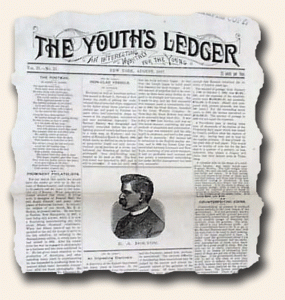 Introductory Issue from the 1800’s…
Introductory Issue from the 1800’s…
209016 An original issue from the 1800’s to help jump start your collection. This issue is guaranteed to be original, complete, and to be dated in the 1800’s. We do not offer reproductions of any kind! There is a limit of 10 issues per customer at this price. See the images for examples of the condition and look of the issue you will receive. The image shows several issues to give you a sense of the various titles/conditions you may receive, but please know this listing is for a single issue – at a great price. $3.00*
The War of 1812…
207496 COLUMBIAN CENTINEL, Boston, dated during the War of 1812. The issue you will receive is similar to the issues shown in the image – slight wear, minor staining and foxing, etc.. The issue will be dated from during the War of 1812, and will have war related news and news of the day. A great issue to own at an incredible price. $7.00*
From France…
153338 GALIGNANI’S MESSENGER, Paris, 1837. An interesting newspaper from France but printed in English, and featuring a black-inked tax stamp on an inside page. Various news of advertisements. Four pages, nice condition. Note: The policy/purpose of this title was to promote good feeling between England and France, and was highly regarded. $13.00*
19th century publication for youth…
152963 THE YOUTH’S LEDGER, New York, NY, 1887. “An interesting monthly for the Young” as is printed in the masthead. See the photo for an example of the “look” of this title from our archives. This is a nice issue to have from this location and period in history. Six pages approximately 16″x11″. $11.00*
Pittsburgh, PA… just before steel production…
153013 THE PITTSBURGH LEADER, Pittsburgh, PA, 1873. State, local and national news from this era. Interesting to have news of the day from just before steel production hit in full force. See the photo for an example of this title from our archives. Note that the photo is “generic” and the issue you get will not have these specific photos or be of this specific date but will have the format as shown. 21″x17″. Four pages and in nice condition. $15.00*
Exploring the influence of war on domestic Life…
153036 ADVOCATE OF PEACE, (Hartford, Connecticut), 1834. An interesting magazine which has war as its theme, and the value of peace as opposed to war. Note that the photo is “generic” and the issue you get will not have this specific date but will have the format as shown. Forty-six pages, measuring 9″x6″, disbound without outer wrappers. $11.00*
Additional issues priced at $15* and under may be viewed at: Entry Level Newspapers
* All prices shown were valid as of the release date of this post.
Intriguing earthquake newspaper…
January 10, 2011 by TimHughes · Leave a Comment
A newspaper I came across recently was one I nearly tossed in the trash believing it to be only the back leaf of a four page newspaper. We have, unfortunately, many such remnants lying around the warehouse. But before tossing the issue aside I noted a heading (see below) near the top of the first column: “FORM PIED ! ” In printing parlance “pied” means the set type was reduced to a jumble by being knocked, dropped, etc. The text notes: “Going to press this afternoon the first and fourth pages of the Dispatch forms were pied by the carrier to the press rooms. We are, therefore, unable to issue more than half a sheet of the paper to-day.” (see) So, this single sheet, without a banner masthead, was a complete newspaper after all.
But even more intriguing is that just below this “pied” report is an early report of the San Francisco earthquake of 1868, headed: “The Earthquake” which begins: “The reports from different quarters show that the great shock yesterday morning was felt with more or less intensity all around the Bay, to a great distance. It appears to have been most severe in Alameda county & the damage to property was large. In this city, the loss has been great, though probably not to the extent that was feared yesterday. Many buildings have been damaged…” with more on both sides of the newspaper.
Of curious interest is whether the type was pied as a result of an aftershock, which always accompany earthquakes. Indeed, a report at the bottom of the page is headed “Shock” and notes: “Another shock of earthquake was felt this morning a few minutes before one o’clock. It was quite perceptibly felt & several left their houses thinking it was the prelude to a heavier one…”. So did the printer’s assistant drop the type for pages 1 and 4 due to an aftershock? We’ll never know, but the combination of the early earthquake report–from the city where it happened–and the reduced state of this edition due to the type being dropped makes for an intriguing newspaper.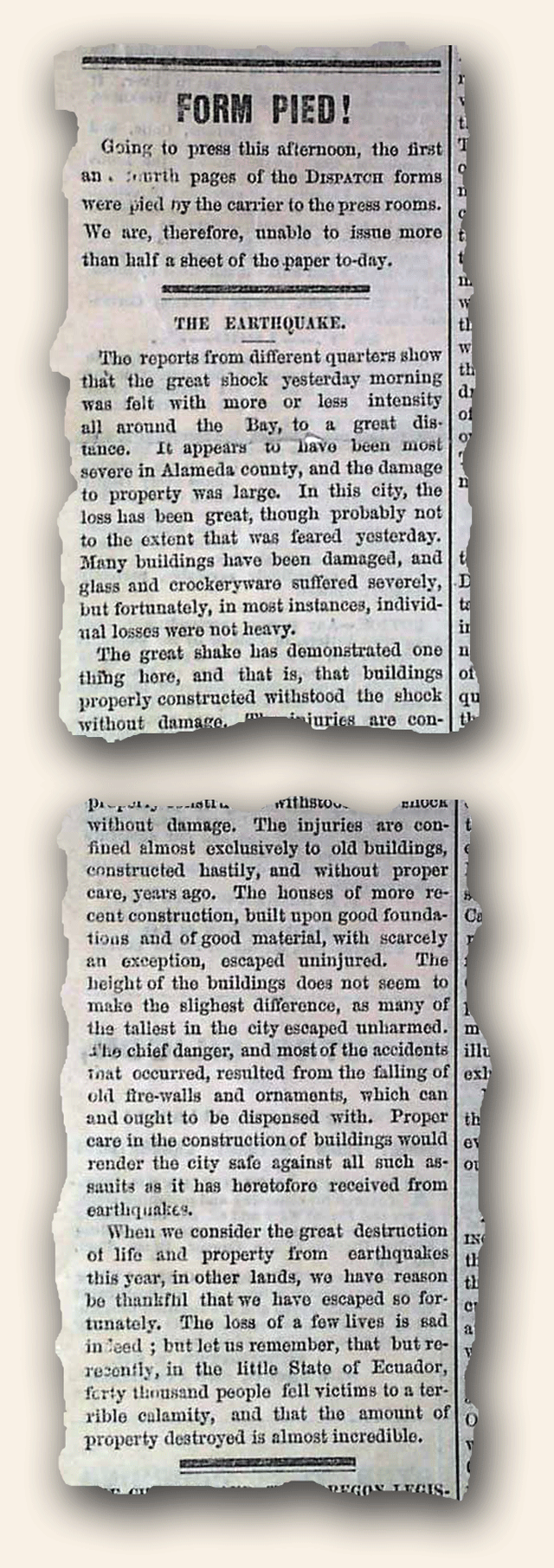
Entry point into the Rare Newspapers Collectible… 20th Century…
January 6, 2011 by GuyHeilenman · 2 Comments
In the past the History’s Newsstand Blog has featured posts on the upper end of the collectible: “Prices Realized” and “Most Collectible Issues“. To kick off the new year we thought it might be nice to look at the other end of the spectrum: “Entry Points to the Rare Newspapers Collectible”. Throughout this month we will target examples of the least expensive collectible newspapers available for each century.
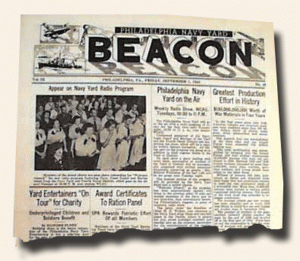 Our journey begins with the 20th century…
Our journey begins with the 20th century…
The following selection provides a glimpse of the wide variety of issues available valued at $15* and under. Areas of interest include shipping, finance, theater, historic events, and more. Many more exist on the Rare Newspapers website, but others can be found throughout the collectible community as well. The item numbers for each are linked to corresponding images.
A World War II newspaper from the Navy Yard…
575571 BEACON, Philadelphia Navy Yard, 1944 A military paper produced at the Navy Yard with a great wealth of war-related content and a war-related masthead as well.
Eight pages, 10 1/2 by 16 pages, printed on high quality paper, nice condition. $9.00*
From the Panama Canal Zone…
579280 THE PANAMA CANAL RECORD, Balboa Heights, Canal Zone, 1928. A little magazine subtitled: “Official Publication of the Panama Canal” with a wealth of data concerning the canal and its use. Approximately twenty-six pages measuring 9″x6″. $12.00*
World War 1…
161488 OFFICIAL BULLETIN, Washington, DC, 1918. An unusual newspaper published daily by the “Committee on Public Information”, meant to keep the public informed of both political & military matters, particularly during the WWI period. Note that the photo is “generic” and the issue you get will be of a slightly different date but will have the format as shown. Sixteen pages measuring 12″x9″. Lightly browned with some minor edge tears. $10.00*
For the little child in all of us…
161498 THE YOUTH’S COMPANION, Boston, Massachusetts, 1900. A charming newspaper with several short stories for children, featuring several wonderful illustrations, an ornate masthead, and plenty of advertisements. $10.00*
In-house real estate periodical…
161495 STROUT’S BUGGY-SEAT CONFIDENCES, Boston, Massachusetts, 1911. A curious little publication by and for those working for the Strout real estate company, the “World’s Largest Farm Agency”. Printed on coated stock. $10.00*
Movie News! Burt Lancaster & Ava Gardner…
564394 MOTION PICTURE DAILY, from New York, dated September 28, 1956. Interesting little publication for and about the movie industry, giving the latest information on the various background events of the motion picture world. Television news as well. Too much to mention. 6 pages measuring 12″x9″, printed on coated stock paper. Nice shape. $10.00*
Additional issues priced at $15* and under may be viewed at: Entry Level Newspapers
* All prices shown were valid as of the release date of this post.
April 15, 1865 New York Herald reprints… revisited…
November 1, 2010 by GuyHeilenman · 10 Comments
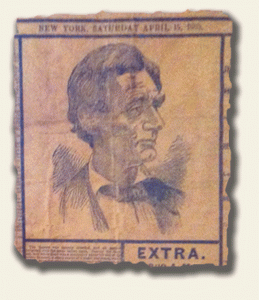 A previous post by guest contributor Rick Brown detailed how one can identify whether or not their April 15, 1865 New York Herald is authentic. One of the most notable differences between an authentic issue (which is quite rare) and one of the reprints (which are rather common) is that the common reprint has an image of President Lincoln on the front page, whereas, the original does not. We recently came across a photo of the Lincoln image (as shown to the right). If your issue has it… unfortunately, your’s is not an original.
A previous post by guest contributor Rick Brown detailed how one can identify whether or not their April 15, 1865 New York Herald is authentic. One of the most notable differences between an authentic issue (which is quite rare) and one of the reprints (which are rather common) is that the common reprint has an image of President Lincoln on the front page, whereas, the original does not. We recently came across a photo of the Lincoln image (as shown to the right). If your issue has it… unfortunately, your’s is not an original.
Prices… a walk down memory lane… 1987…
October 25, 2010 by GuyHeilenman · Leave a Comment
Blondie, Kool & the Gang, Ambrosia… Rubik’s Cube, Break Dancing, Transformers… The A-Team, 21 Jump Street, Moonlighting… the 80’s! Our walk through time now brings us to the 8o’s. Our exploration of authentic newspaper pricing through time takes us back to Catalog 60. To see a larger image of the catalog’s page, go here: Catalog 60


